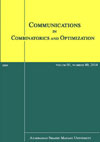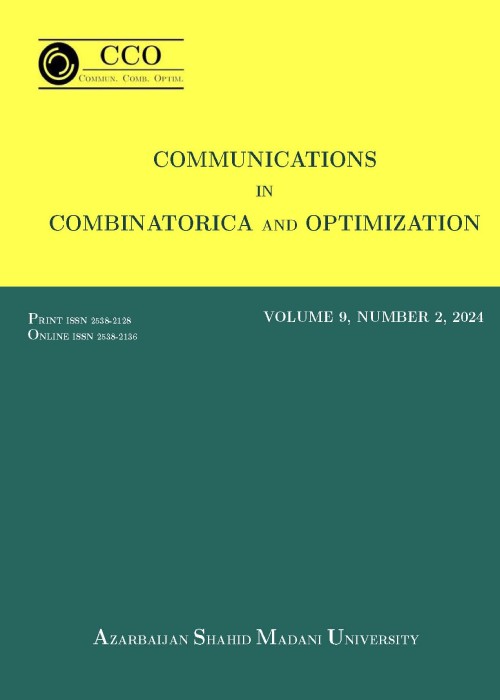فهرست مطالب

Communications in Combinatorics and Optimization
Volume:7 Issue: 1, Winter-Spring 2022
- تاریخ انتشار: 1400/08/05
- تعداد عناوین: 12
-
-
Pages 1-16ÞFor a given graph G, its Þ-energy is the sum of the absolute values of the eigenvalues of the Þ-matrix of G. In this article, we explore the Þ-energy of generalized Petersen graphs G(p,k) for various vertex partitions such as independent, domatic, total domatic and k-ply domatic partitions and partition containing a perfect matching in G(p,k). Further, we present a python program to obtain the Þ-energy of G(p,k) for the vertex partitions under consideration and examine the relation between them.Keywords: Graph energy, partition matrix, Þ-matrix, vertex partitions
-
Pages 17-27Let k≥ 1 be an integer. A weak signed Roman k-dominating function on a graph G isa function f:V (G)→ {-1, 1, 2} such that ΣuεN[v] f(u)≥ k for everyvε V(G), where N[v] is the closed neighborhood of v.A set {f1,f2, ... ,fd} of distinct weak signed Roman k-dominatingfunctions on G with the property that Σ1≤i≤d fi(v)≤ k for each vε V(G), is called a weak signed Roman k-dominating family (of functions) on G. The maximum number of functionsin a weak signed Roman k-dominating family on G is the weak signed Roman k-domatic number} of Gdenoted by dwsR k(G). In this paper we initiate the study of the weak signed Roman $k$-domatic numberin graphs, and we present sharp bounds for dwsR k(G). In addition, we determine the weak signed Roman k-domatic number of some graphs.Keywords: weak signed Roman k-dominating function, weak signed Roman k-domination number, weak signed Roman k-domatic number
-
Pages 29-44In this paper, we present a second-order corrector infeasibleinterior-point method for linear optimization in a largeneighborhood of the central path. The innovation of our method is tocalculate the predictor directions using a specific kernel functioninstead of the logarithmic barrier function. We decompose thepredictor direction induced by the kernel function to two orthogonaldirections of the corresponding to the negative and positivecomponent of the right-hand side vector of the centering equation.The method then considers the new point as a linear combination ofthese directions along with a second-order corrector direction. Theconvergence analysis of the proposed method is investigated and itis proved that the complexity bound is Ο(n5/4 log ε-1).Keywords: Linear optimization, predictor-corrector methods, wide neighborhoods, Polynomial complexity
-
Pages 45-51
A signed graph is a graph in which each edge has a positive or negative sign. In this article, we define n^th power of a signed graph and discuss some properties of these powers of signed graphs. As we can define two types of signed graphs as the power of a signed graph, necessary and sufficient conditions are given for an n^th power of a signed graph to be unique. Also, we characterize balanced power signed graphs.
Keywords: Signed graph, Signed distance, Distance compatibility, Power of signed graphs -
Pages 53-57If A(G) and D(G) are respectively the adjacency matrix and the diagonal matrix of vertex degrees of a connected graph G, the generalized adjacency matrix Aα(G) is defined as Aα(G)=α D(G)+(1-α) A(G), where 0≤ α ≤ 1. The Aα (or generalized) spectral radius λ(Aα(G)) (or simply λα) is the largest eigenvalue of Aα(G). In this paper, we show that λα ≤αΔ+(1-α)(2m(1-1/ω))1/2, where m, Δ and ω=ω(G) are respectively the size, the largest degree and the clique number of $G$. Further, if G has order n, then we show that 2λα ≤ max1≤i≤n [αdi + √α2 di ^2 +4mi(1-α)[α+(1-α)mj] where di and mi are respectively the degree and the average 2-degree of the vertex vi.Keywords: Adjacency matrix, generalized adjacency matrix, spectral radius, clique number
-
Pages 59-68In this paper, we initiate the study of total outer-convex domination as a new variant of graph domination and we show the close relationship that exists between this novel parameter and other domination parameters of a graph such as total domination, convex domination, and outer-convex domination. Furthermore, we obtain general bounds of total outer-convex domination number and, for some particular families of graphs, we obtain closed formulas.Keywords: Domination number, total domination number, convex domination, total outer-convex domination number, grid graphs
-
Pages 69-79To extract some more information from the constructions of matroids that arise from new operations, computing the Tutte polynomial, plays an important role. In this paper, we consider applying three operations of splitting, element splitting and splitting off to a binary matroid and then introduce the Tutte polynomial of resulting matroids by these operations in terms of that of original matroids.Keywords: Tutte polynomial, Splitting, Splitting off, Element splitting
-
Pages 81-90The energy of a graph G, denoted by Ε(G), is defined as the sum of the absolute values of all eigenvalues of G. In this paper, lower and upper bounds for energy in some of the graphs are established, in terms of graph invariants such as the number of vertices, the number of edges, and the number of closed walks.Keywords: Eigenvalue of graph, Energy, spectral radius, The number of closed walks
-
Pages 91-92In this short note, we disprove the conjecture of Jafari Rad and Volkmann that every γ-vertex critical graph is γR-vertex critical, where γ(G) and γR(G) stand for the domination number and the Roman domination number of a graph G, respectively.Keywords: γ -vertex critical graphs, γ, {R}-vertex critical graphs, Roman domination
-
Pages 93-104For a simple, undirected, connected graph G=(V,E), a function f : V(G) →{0, 1, 2} which satisfies the following conditions is called a quasi-total Roman dominating function (QTRDF) of G with weight f(V(G))=ΣvΕV(G) f(v).C1). Every vertex uεV for which f(u) = 0 must be adjacent to at least one vertex v with f(v) = 2, and C2). Every vertex uεV for which f(u) = 2 must be adjacent to at least one vertex v with f(v)≥1. For a graph G, the smallest possible weight of a QTRDF of G denoted γqtR(G) is known as the quasi-total Roman domination number of G. The problem of determining γqtR(G) of a graph G is called minimum quasi-total Roman domination problem (MQTRDP). In this paper, we show that the problem of determining whether G has a QTRDF of weight at most l is NP-complete for split graphs, star convex bipartite graphs, comb convex bipartite graphs and planar graphs. On the positive side, we show that MQTRDP for threshold graphs, chain graphs and bounded treewidth graphs is linear time solvable. Finally, an integer linear programming formulation for MQTRDP is presented.Keywords: Domination number, quasi-total Roman domination, complexity classes, graph classes, linear programming
-
Pages 105-112A subset S of vertices in a graph G = (V;E) is 2-independent if every vertexof S has at most one neighbor in S: The 2-independence number is the maximumcardinality of a 2-independent set of G: In this paper, we initiate the study of the2-independence subdivision number sdβ2(G) defined as the minimum numberof edges that must be subdivided (each edge in G can be subdivided at mostonce) in order to increase the 2-independence number. We first show that forevery connected graph G of order at least three, 1≤sdβ2(G)≤2; and we give anecessary and sufficient condition for graphs G attaining each bound. Moreover,restricted to the class of trees, we provide a constructive characterization of alltrees T with sdβ2(T)= 2; and we show that such a characterization suggestsan algorithm that determines whether a tree T has sdβ2(T)= 2 or sdβ2(T) = 1in polynomial time.Keywords: trees, 2-independence, subdivision numbers
-
Pages 113-120The chromatic number, Χ(G) of a graph G is the minimum number of colours used in a proper colouring of G. In improper colouring, an edge uv is bad if the colours assigned to the end vertices of the edge is the same. Now, if the available colours are less than that of the chromatic number of graph G, then colouring the graph with the available colours leads to bad edges in G. The number of bad edges resulting from a δ(k)-colouring of G is denoted by bk(G). In this paper, we use the concept of δ(k)-colouring and determine the number of bad edges in the Cartesian product of some graphs.Keywords: Improper colouring, near proper colouring, δ^(k)-colouring, bad edge


